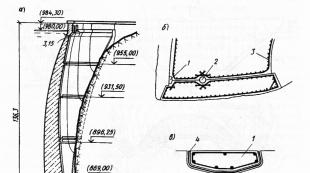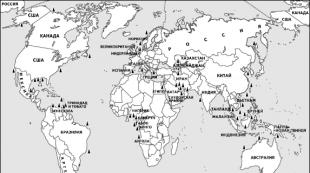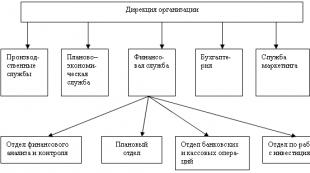Great Soviet Encyclopedia - dam. Fundamentals of hydropower. The Chinese built arch dams on a large scale and to last for centuries.
Of all the dams, arch dams certainly make the greatest impression. It seems absolutely incredible how a thin curved concrete wall can hold billions of tons of water, and at the same time have a huge margin of safety. Well, in the end, arched dams are simply very beautiful.
Xiaowan is the highest arch dam in the world. Photo from here
The operating principle of arch dams is fundamentally different from all other types of dams. If gravity and buttress dams put pressure on the base, then arch dams transfer the load to the banks. An arched dam can even be specially cut off from the base using a special cut seam (this is sometimes done to relieve the stresses that arise in some types of dams).

Lumei Dam with a seam at the base
At the same time, the concrete in the arch dam works under compression, and in such a situation its strength is extremely high. Accordingly, an arch dam can be surprisingly thin - at a height of a hundred meters, its thickness can be only 2-3 m.

At the same time, such thin arched dams are not always built. Depending on specific conditions, it may be more effective to build a thicker or even an arch-gravity dam, the stability of which is ensured by both the emphasis on the banks and its own weight.

The main advantage of a concrete dam is significant savings in concrete, reaching 80% of the amount of concrete in a gravity dam. At the same time, arch dams place special demands on the banks - the width of the valley, its shape and the quality of the rocks.

Inguri Dam. Photo from here
In wide valleys, the construction of arch dams is ineffective. There is a special coefficient that reflects the ratio of the length of the arched dam along the crest to its height (L/H). The most effective construction of arch dams is if this coefficient does not exceed 3.5, although there are known cases of construction of arch dams in relatively wide sections - for example, for the Sayano-Shushenskaya hydroelectric power station L/H = 4.56, for the Pieve di Cadore dam in Italy L/H=7.45.

Pieve di Cadore Dam. Photo from here
They do not like arched dams and asymmetrical valleys - the arch does not work normally in them. If necessary, they even resort to the construction of special tie-ins and retaining walls. And finally, the rocks into which the arch dam rests must be very strong. Accordingly, the ideal place for an arch dam is a mountain gorge, where they are mainly built.

Scheme of the Xiaowan hydroelectric dam.
The stability of arch dams is extremely high. In model experiments, they were destroyed only under loads 3-5 times higher than the calculated ones. There is a well-known example of a disaster at the Vayont dam (very high and very thin), when a landslide in the reservoir caused an overflow of water over the dam in a layer of at least 70 m - the dam stood and, moreover, was almost not damaged.

Vayont Dam. Photo from here
There are few arch dams in Russia - three purely arch dams (Chirkeyskaya, Miatlinskaya and Gunibskaya) and two arch-gravity dams (Sayano-Shushenskaya and Gergebilskaya). There is a project for the Agvalinskaya hydroelectric power station on the Andiiskoye Koysu River with an arch dam 210 m high.

Chirkey hydroelectric power station. Photo from here
The highest arch dam in the world is the dam of the Chinese Xiaowan hydroelectric power station on the Mekong River with a height of 292 m, commissioned in 2010. Before that, for a long time the leadership was held by the Inguri hydroelectric power station dam in Georgia, its height is 271.5 m. Many high-rise arch dams are being built in China - for example, the Xiluodu hydroelectric power station dam is 278 m high (by the way, the power of the hydroelectric power station is also impressive - 13,860 MW!). The highest arch dam in the world is also being built there - Zhinping-1 with a height of 305 m. However, this is not the limit - there is a beautiful project for the Abu Sheneila Dam in Sudan with a height of 335 m!
Man is not just a child of nature. He tries to change the environment around him, to make it more comfortable for living. This makes him different from animals. For a long time, people have tried to curb the elements so as not to depend on the vagaries of nature and weather. So, they learned to build dams so that there would always be water for irrigating fields and watering animals. This engineering device helps people conserve and rationally use both water and land resources, and also prevents devastating floods.
What is a dam?
A dam is a barrier that holds back or controls the flow of water. Thanks to them, artificial reservoirs are created in which life-giving liquid is accumulated and then consumed as needed.
In addition to storage functions, a dam on a river can bring even greater benefits when the power of the water flow powers power plants that supply cities and towns with electricity. Over the years, people have learned not only to control rivers, but also to force them to work for the benefit of the country.
Complex structure
A dam is a hydraulic structure with various functions. During the construction of each new structure, preliminary work is carried out, as a result of which an economic justification is made and the technical capabilities of the future structure are calculated. Construction of a dam is a complex and labor-intensive process that requires highly qualified workers both at the design stage and during its construction and further operation.

Types of dams
A dam is a structure that is not built according to a single model. Each specific object requires its own parameters and calculations. There are several types of dams.
Solid reinforced concrete has an almost unlimited safety margin. This material is capable of holding back powerful flows of water. They are also called gravity because they are held on the surface of the earth due to the force of gravity, firmly fixing the reinforced concrete in place. These dams are very expensive because they consist entirely of the specified material. Therefore, they are built only on the most powerful rivers and are used for a very long time.

Dams made of hollow reinforced concrete are much cheaper than solid ones. Their insides are reinforced with steel reinforcement of various sections to increase the safety factor.
Earthen ones are built from soil, stones, sand to hold back the flow of water. They are often erected in areas of river floods as temporary barriers around populated areas.
Another type of dam is levees and embankments, which are designed to prevent flooding if river levels rise. The height of the dam depends on its technical characteristics. Earthen ones are rarely poured higher than 15 meters, but reinforced concrete ones can be of almost any height required by the project.
Historical facts
Dams are structures that have been built since ancient times. The oldest known is over 4,500 years old and was discovered in Egypt.

But one of the world's largest hydraulic structures - the Hoover Dam on the Colorado River - was built back in 1930 in the USA and is still in use. Its length is 379 m with a height of 221 m. Dam workers claim that the layer of reinforced concrete here is so thick that in the central part it still, after almost 90 years, has not yet hardened. Thanks to this structure, the largest artificial lake in the world arose - Lake Mead, which supplies water to several arid states.
A dam is a peaceful structure. But there have been cases in history when such objects were used for military purposes. Often, during the siege of a city, invaders blocked the riverbed with an earthen dam, changing the direction of the water flow. The besieged inhabitants, exhausted from thirst, opened the gates. There were also opposite situations, when a rebellious town was flooded with the help of a dam. Many such structures were blown up during World War II so that the Nazis could not penetrate deep into the country.

By the way, according to one version of historians, the unfound grave of Genghis Khan also rests at the bottom of the river, which is why its search took so long. The construction of dams is a technique that this powerful conqueror often used.
Modern dams often perform three functions at once - they protect against floods, allow the accumulation of water reserves and help produce electricity.
A dam is a structure that helps block the rise of water or its flow for one purpose or another. The very first buildings of this type were discovered in Egypt, where they were used to create water storage facilities. Archaeologists from Germany found such an object two hundred kilometers from Cairo. It was a dam with its own name, "Sad el-Qaraf", which appears in the records of Herodotus. Experts disagree about her age. Some believe that it was built in 3200 BC, others believe that it was built between 2950-2750.
What was the oldest dam made of?
What size was the oldest dam? This impressive structure was a double stone wall, with additional stone fragments thrown between the sides. The length of the dam was more than 100 meters along the crest, and the height reached 12 meters. A similar project made it possible to accumulate up to two million cubic meters of water in Wadi al-Gharawi.
The Chinese built on a large scale and to last for centuries.
Some historians believe that dams were built everywhere at the points of development of one or another local civilization. For example, a stone structure dating back to the seventh century BC was found in Mesopotamia. In ancient Syria, similar structures were built one and a half thousand years before the birth of Christ. (Nahr el-Assi). Large-scale construction of dams was also observed in Ancient China. The master became famous here, and later Emperor Yu, to whom in 2283 BC the current ruler entrusted the management of all water construction in the empire. Under the leadership of the Great Yu (as he is still called), more than one dam was built. This was a large-scale construction that lasted for centuries and millennia, which made it possible by 250 BC to irrigate, for example, 50,000 square kilometers in the deserts of Sichuan using the waters of the Minjiang River. And it was in China that the practice of building hydraulic structures using an element such as an arch arose.

They were designed by da Vinci himself
In Europe, where the problem of irrigation was not as acute as in Asia and Africa, dams appeared much later - in the 16th century. Arched versions, in particular, are mentioned in Spanish chronicles in 1586, but engineers believe that the devices themselves could have been built centuries earlier. This is based on the fact that the geniuses of that time participated in their design - Leonado da Vinci, Malatesta, Mechini, as well as taking into account the accumulated experience that came to Europe after contacts with the Arab world. For example, it is known that even such a seemingly not very strong structure as an earthen dam was in use for a century before it collapsed (it was erected in France in 1196).
Use of dams in Rus'
For Rus', with its rich water resources, also, at first glance, there was no particular need for dams. However, they have existed here since the 14th century AD and were used in systems. The first mention of dams is noted in the will of Dmitry Donskoy, dating back to 1389. Peter the Great showed particular interest in such structures, so in the 18th century there were already more than 200 objects in the Russian Empire, among which the high earthen dam, Zmeinogorskaya, stood out. Water resources were transferred through such devices for use in textile, mining and other enterprises of the time.

A dam is something that can refer to one or another type of object depending on the classification. Today there are water storage, water lowering and lifting devices. Reservoir dams are usually very high and have the ability to regulate water release. Low structures (for example, for constructing ponds) usually do not have drainage. Another important classification is the division of objects depending on the depth of water before the dam. There are low-, medium- and high-pressure dams here (up to 15, 50 and more than 50 meters, respectively).
Dams for rivers and ravines
Dams on rivers can be built both across (to raise the water level, to create a waterfall, the power of which can be somehow used; to make shallow water passable for ships) and along (to protect against floods). In some cases, dams block streams, ravines, and hollows to retain melted snow water, which is then used for irrigation or to recharge shipping canals.

Main elements of a hydroelectric power station
Hydraulic structures usually include a dam, a reservoir before or after it, an installation for raising water, a complex of hydroelectric power stations, descents for the passage of fish, drainage of water (if the system is culverted), and structures for cleaning the system from sediment. Large objects are made of reinforced concrete, while small ones can be built from soil, metal, concrete, wood or even fabric. It is known that during the flood in Komsomolsk-on-Amur, the protective dam consisted of soldiers from the Ministry of Emergency Situations holding sheets of film on themselves, which prevented the water from overflowing over the tops of the existing protective structures.

How can dams take the load?
Another classification of dams reflects how these objects resist loads. Gravity buildings absorb impacts with their entire mass and resist due to the adhesion of the base of the dam and the foundation on which it stands. Such options are usually very massive. For example, the hydroelectric dam on the Indus River (Tarbela Dam) has a height of about 143 meters and a length of more than 2.7 km, which creates a total volume of 130 million cubic meters. meters. Arched objects transfer pressure to the banks. If the arch is wide and the pressure is high, then gravity arch models or arches with buttresses at the base are used. Buttress options have a thinner dam wall, but a reinforced base due to supporting elements. Today, dams are built using the fill or alluvium method, as well as the directed explosion method.
Consequences of accidents
Accidents at dams entail significant material losses, since not only unique equipment is destroyed, but also enterprises that operate on electricity and water supplies from the dam are shut down. Sometimes entire settlements are washed away by water flows, crop areas are flooded, and crops are lost. But the worst thing is that tens, hundreds and even thousands of people can die almost instantly.
So, in March 1928, the destruction of the St. Francis dam occurred in the San Francisquito Canyon, then about six hundred people died, and multi-meter pieces of the dam itself were found at a distance of about a kilometer from the site of the breakthrough. In the USSR, during the Great Patriotic War (1941), a decision was made to deliberately blow up the Dnieper Hydroelectric Dam in connection with the occupation of Zaporozhye by fascist troops. The massive concrete structure was partially damaged by 20 tons of ammonal. How many people died then is still not precisely determined. They give figures from twenty to one hundred thousand people, including troops, refugees and the population that could be on the left bank of the Dnieper, which took the brunt of the water disaster.

The total number of victims is about 230 thousand people
Post-war accidents at dams at large power plants resulted in even greater casualties. In August 1975, when the Banqiao dam broke, 26,000 people were drowned alone, and taking into account the spread of epidemics and famine, the death toll reached 170-230 thousand people. At the same time, about a third of a million heads of livestock were destroyed and about 6 million buildings and structures were destroyed. The highway from Guangzhou to Beijing was closed for eighteen days. And all this happened because the dams, designed for maximum rainfall, could not withstand the onslaught of water masses brought by Typhoon Nina. On August 8, 1975, the smallest of the dams collapsed, which led to the release of water into Bancao, where 62 dams were broken in a short time. The resulting wave was up to 10 km wide and three to seven meters high. Some Chinese villages were completely washed away along with their inhabitants.

To prevent a dam from breaking, a number of measures are being taken today, including compliance with the dam design parameters, checking for compliance during work, observations during operation, collecting visual and geodetic information, etc. For dams, two non-compliances with the requirements of projects and standards are distinguished: “K1 " - the object has a potentially dangerous condition and urgent measures are needed to eliminate its causes, and "K2" - a pre-emergency condition, destruction is possible, rescue and evacuation work is needed.
In publications on the topic of hydraulic engineering and hydropower, there are often a lot of terms that are completely understandable to specialists, but not so clear to everyone else. In this regard, we are starting a series of publications devoted to the basics of hydraulic engineering and hydropower. In them we will talk about what types of dams and turbines there are, why hydroelectric power gates and SF6 gas switches are needed - and much more. Today I will talk about what types of dams there are; In the future, we will dwell on each type in more detail.
Roosevelt Arch Dam
All dams can be roughly divided into two groups: soil and concrete (we can ignore various exotics, such as metal, fabric or wooden dams, as they are practically not used in modern hydropower engineering).
Earth dams
As their name suggests, earth dams are built from ground materials - sand, loam, stone. They are all gravitational, i.e. their stability is ensured by their weight. The advantages of earth dams are the simplicity and manufacturability of their creation, the use of readily available local materials, and high seismic resistance. The disadvantages are the need for special measures to combat filtration, more complex and expensive spillway structures, and instability when water flows over the crest.
Soil dams are divided depending on the material used in their creation - into earthen, stone and stone-earth. Earth dams are most widely used, especially at lowland hydroelectric facilities, where they are part of the pressure front in 99% of cases.

Scheme of the Nurek hydroelectric power station dam
Concrete dams
Concrete dams are divided into three large groups - gravity, buttress and arch.
Gravity dams maintain stability due to their weight. They are simple, reliable, technologically advanced, and can be easily combined with water discharge structures and hydroelectric power station buildings, and therefore have become very widespread. From low-head spillway dams in run-of-river hydroelectric projects to high-rise dams in the mountains, this type of dam can be seen everywhere. The main disadvantage is that such a dam requires a lot of concrete.

Gravity concrete dam of the Krasnoyarsk hydroelectric power station
Buttress dams work mainly not due to weight, but by transferring forces to the foundation with the help of special retaining walls - buttresses. This dam design requires significantly less concrete, but is significantly more difficult to construct.

Types of buttress dams.
Arch dams transfer water pressure to the banks. The concrete in them works under compression, and in this case its strength is very high. Therefore, arch dams can be very thin and economical. The disadvantages of arch dams are the impossibility of their construction in wide sections, as well as the presence of special requirements for the quality and configuration of the slopes.

Arch dam of the Inguri hydroelectric power station
Dam a hydraulic structure that blocks a river (or other watercourse) to raise the water level in front of it, concentrate pressure at the location of the structure and create a reservoir. The water-economic importance of P. is diverse: the rise in water level and the increase in depths in the upper pool favor shipping, timber rafting, as well as water intake for the needs of irrigation (See Irrigation) and water supply (See Water supply). ;
the concentration of pressure near the river creates the possibility of energy use of river flow; the presence of a reservoir makes it possible to regulate the flow, i.e., increase the water flow in the river during low-water periods and reduce the maximum flow during a flood, which can lead to destructive floods. The river and the reservoir significantly affect the river and adjacent territories: the river flow regime, water temperature, and the duration of freeze-up change; fish migration becomes difficult; the banks of the river in the upper pool are flooded; The microclimate of coastal areas is changing. P. is usually the main structure of a waterworks complex (See Waterworks).
Dam engineering arose as long ago as hydraulic engineering ,
in connection with the significant development of artificial irrigation of territories among the agricultural peoples of Egypt, India, China and other countries. The construction of P. was required for the construction of hydraulic power plants, and then the construction of hydroelectric power stations. The energy use of water resources was the main incentive for increasing the size and improving the design of waterways and the appearance of hydraulic structures on high-water rivers. On the territory of the USSR, water mills with water were built back in the days of Kievan Rus. In the 17th-19th centuries. mining, metallurgy, textile, paper and other industries in the Urals, Altai, Karelia and central regions of Russia used mainly the mechanical energy of hydraulic power plants; their buildings were small in size and were constructed from local materials. Powerful hydroelectric power stations with large concrete and earthen pumps began to be built only under Soviet power, after the adoption of the GOELRO plan. In 1926, the first concrete spillway of the Volkhov hydroelectric power station was built. In 1932, a high concrete P. Dnieper hydroelectric power station was built (its maximum height is about 55 m).
The spillway reservoir of the Nizhnesvirskaya hydroelectric power station is the first reservoir built on weak clay soils. In the 50-70s. on high-water rivers were built: alluvial earthen P. on the Volga near Kuibyshev and Volgograd, concrete P. Bratsk hydroelectric power station on the Angara (height 128 m) and the Krasnoyarsk hydroelectric power station on the Yenisei (124 m) (rice. 1
), a high 300-meter stone-earth P. Nurek hydroelectric power station on the river. Vakhsh, arched P. Sayan hydroelectric power station on the Yenisei (height 242 m, ridge length 1070 m; is under construction, 1975) and many others. The design and construction of dams in the USSR are distinguished by a high technical level, which allowed Soviet dam construction to occupy one of the leading places in the world. Of the P. built abroad, it should be noted: multi-arched P. Bartlett, height 87 m(USA, 1939), stone P. Paradella, height 112 m(Portugal, 1958), earthen P. Ser-Ponson, height 122 m(France, 1960), stone-earth P. Miboro, height 131 m(Japan, 1961), gravity concrete P. Grand Dixence, height 284 m(Switzerland, 1961). The type and design of a building are determined by its size, purpose, as well as natural conditions and the type of main building material. Based on their purpose, a distinction is made between reservoir reservoirs and water-lifting reservoirs (intended only for raising the level of the upper pool). Based on the pressure, pumps are conventionally divided into low-pressure (with a pressure of up to 10 m),
medium pressure (from 10 to 40 m) and high-pressure (more than 40 m).
Depending on the role performed as part of a waterworks, the water supply can be: deaf, if it serves only as a barrier to the flow of water; drainage, when it is intended to discharge excess water flows and is equipped with surface drainage holes (open or with gates) or deep drainages; station, if it has water intake openings (with appropriate equipment) and water conduits feeding hydroelectric power station turbines. Based on the main material from which dams are built, a distinction is made between earthen dams (See Earthen dam), stone dams (See Stone dam), concrete dams (See Concrete dam), and wooden dams (See Wooden dam).
Earthen P. is constructed entirely or partially from low-permeability soil. Low-permeable soil laid along the upper slope of the P. forms a screen; When such soil is located inside the body of the soil, a core is created. The presence of a screen or core makes it possible to construct the rest of the pavement from permeable soil or from stone materials (stone-earth pavement). At the bottom of the lower slope of the earthen P., drainage is installed to drain water filtered through the body and base of the P. The upper slope of P. is protected from the effects of waves by concrete slabs or rock riprap. When constructing an earthen embankment, soil is extracted from a quarry using excavators, transported to the construction site by dump trucks, placed in the body of the structure, leveled with bulldozers, and compacted layer by layer with rollers. The construction of alluvial soil involves the development of soil by dredgers or hydraulic monitors, transportation of the pulp through pipes and its distribution over the surface of the constructed soil, after which the water drains away and the settling soil compacts itself. To prepare the foundation and erect an earthen P. in the river bed, its foundation pit is fenced off with a jumper. ,
and the river is diverted through pre-laid temporary conduits, which are closed after the construction of the P. In stone (fill-fill) paving, the screen or central waterproof element (diaphragm) is made of reinforced concrete, asphalt, wood, metal, and polymer materials. The requirement of low water permeability also applies to the base of the P. If the base soil is permeable to a great depth, it is covered in front of the P. Ponur (for example, made of clay), forming one whole with the screen. P. with a core is complemented by a device at the base of a steel sheet pile wall or an anti-filtration curtain (See Anti-filtration curtain) .
The stone in rockfill and rock-earth paving is poured in layers of great height. Concrete floors are usually classified according to their design, depending on the shear operating conditions. ;
Accordingly, there are 3 main types of P. ( rice. 2
) - gravity dams (See Gravity dam), arch dams (See Arch dam), buttress dams (See Buttress dam). Basic The material for modern concrete floors (mostly gravity-based) is hydraulic concrete. One of the most important issues when constructing concrete substructures is reducing water filtration at the base. For this purpose, an anti-filtration curtain is installed at the base of a high concrete floor near the top edge. In the remaining section, the base is drained to reduce water pressure on the base of the floor, which increases the stability of the structure. To avoid the formation of cracks due to temperature fluctuations, gravity and buttress panels are cut lengthwise into short sections, the seams between which are covered with waterproof seals (see Waterproofing). To prevent the appearance of cracks as a result of shrinkage of concrete during hardening and to reduce thermal stresses, the concrete block is concreted in separate blocks of limited sizes; artificial cooling of the components of the concrete mixture and the concrete laid in the blocks is used by circulating coolant (from the refrigeration unit) through a system of pipes laid in the body of the concrete block. Concrete pavement in the riverbed is usually constructed in 2 stages under the protection of lintels enclosing the pits. During the construction of the first stage of the river, the river flows along the free part of the riverbed; with the second - through the holes left in the P. (Proran y) ,
which are closed upon completion of all construction work. If the river bed is narrow, a concrete waterway is built in one step, with the river temporarily diverted into coastal waterways. Low-pressure concrete spillway dam, common in hydraulic engineering practice ,
erected on a non-rocky foundation and designed to pass large flows of water, has the design shown in rice. 3
. It is based on drainage spans formed by concrete Flytbet and Bulls and blocked by hydraulic gates (See Hydraulic gate) .
Behind the spillways, a massive fastening of the channel is installed - Vodoboy (sometimes buried in the form of a water well), then there is a lighter fastening - Apron. Drainage is installed under the reservoir. The spillway is connected to the shores or earthen P. by massive abutments. A low-pressure concrete spillway is usually built using reinforcement, often the entire structure (see Reinforced concrete dam). In order to save material, flutbet and bulls of this kind are sometimes made of a lightweight cellular structure, with the cells filled with soil. In forest areas, low-pressure wooden pumps of pile and cord construction are often built (usually they are equipped with spillways). A special type of water-retaining structure is a collapsible navigable reservoir. To erect it in summer low water, buttresses made of steel trusses are installed on a flat surface, bridges are laid across them, on which gates of the simplest design rest. The port supports the level of the upper pool, and ships and rafts go through the lock. During high-water periods, gates and bridges are removed, buttress trusses are laid on the flatbet, opening the way for ships and rafts through the P. The general trend of modern dam construction is to increase the height of the dam. Technically achieved heights can be exceeded, however, from an economic point of view, the construction of two successive dams of lower height often turns out to be more rational than one high one. Improvement of types of construction made from soil materials is carried out while simultaneously reducing the cost and speeding up their construction by increasing the power of construction mechanisms and vehicles. Increasing the efficiency of concrete floors is achieved by reducing their volume, replacing gravitational floors with buttresses, and the wider use of arched floors. This trend is accompanied by an improvement and specialization of the properties of cement and concrete. It is very effective to combine a spillway dam and a hydroelectric power station building in one structure, which ensures a reduction in the concrete (most expensive) part of the pressure front of the hydroelectric complex. This problem is solved both by placing hydraulic units in a high-pressure cavity and by using an underwater array of a low-pressure hydroelectric power station to install spillway openings in it. Lit.: Grishin M. M., Hydraulic structures, M., 1968; Nichiporovich A. A., Dams from local materials, M., 1973; Moiseev S.N., Rock-earth and rock-fill dams, M., 1970; Grishin M. M., Rozanov N. P., Concrete dams, M., 1975; Production of hydraulic engineering works, M., 1970. A. L. Mozhevitinov. Great Soviet Encyclopedia. - M.: Soviet Encyclopedia.
1969-1978
.


See what “Dam” is in other dictionaries:
On Lake Gordon This term has other meanings, see Dam (meanings). A dam is a hydraulic structure that blocks ... Wikipedia
DAM, a barrier built across a stream, river, estuary or part of the sea. The dam stores water and also regulates the supply of water for irrigation purposes. Dams also serve to prevent floods and as a basis for the operation of hydroelectric power plants.… … Scientific and technical encyclopedic dictionary
Dam, dam, pier, embankment, barrier, road. ... .. Dictionary of Russian synonyms and similar expressions. under. ed. N. Abramova, M.: Russian Dictionaries, 1999. dam dam, dam, pier, embankment, barrier, dam; jumper; hydraulic dam, dam... Synonym dictionary
Dam- Bratsk hydroelectric power station. DAM, a hydraulic structure that blocks a river (or other watercourse) to raise the water level in it, concentrate pressure at the location of the structure, and create a reservoir. Dams can be blind or spillway; ... Illustrated Encyclopedic Dictionary
DAM, dams, women. 1. A dam, a structure made of earth, stone, iron, concrete, etc., built across a river to raise the water level or across a ravine to form an artificial pond. “The miller’s water has sucked through the dam.” Krylov... ... Ushakov's Explanatory Dictionary
dam- A water-retaining structure that blocks a watercourse and its valley to raise the water level [GOST 19185 73] dam A water-retaining structure that blocks a watercourse and (sometimes) the valley of a watercourse to raise the water level. [SO 34.21.308 2005] dam... ... Technical Translator's Guide
dam- A hydraulic structure made of alluvial soil (earthen dam), stone, concrete (concrete dam), protecting the banks of rivers and seas from erosion and flooding, as well as creating backwater on reservoirs. → Fig. 80 Syn.: dam… Dictionary of Geography









